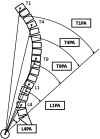Reliability of Vertebral Pelvic Angles in Assessment of Spinal Alignment
- PMID: 38382044
- PMCID: PMC11571524
- DOI: 10.1177/21925682241235607
Reliability of Vertebral Pelvic Angles in Assessment of Spinal Alignment
Abstract
Study design: Reliability analysis.
Objectives: Vertebral pelvic angles (VPA) are gaining popularity given their ability to describe the shape of the spine. Understanding the reliability and minimal detectable change (MDC) is necessary to determine how these measurement tools should be used in the manual assessment of spine radiographs. Our aim is to assess intra- and interobserver intraclass correlation coefficients (ICC) and the MDC in the use of VPA for assessing alignment in adult spinal deformity (ASD).
Methods: Three independent examiners blindly measured T1, T4, T9, L1, and L4PA twice in ASD patients with a 4-week window after the initial measurements. Patients who had undergone hip or shoulder arthroplasty, fused or transitional vertebrae, or whose hip joints were not visible on radiographs were excluded. Power analysis calculated a minimum sample size of 19. Both intra- and interobserver ICC and MDC, which denotes the smallest detectable change in a true value with 95% confidence, were calculated.
Results: Out of the 193 patients, 39 were ultimately included in the study, and 390 measurements were performed by 3 raters. Intraobserver ICC values ranged from .90 to .99. The interobserver ICC was .97, .97, .96, .95, and .92, and the MDC was 5.3°, 5.1°, 4.8°, 4.9°, and 4.1° for T1, T4, T9, L1, and L4PA, respectively.
Conclusion: All VPAs showed excellent intra- and interobserver reliability, however, the MDC is relatively high compared to typical ranges for VPA values. Therefore, surgeons must be aware that substantial alignment changes may not be detected by a single VPA.
Keywords: adult; observer variation; radiography; reproducibility of results; scoliosis.
Conflict of interest statement
Declaration of Conflicting InterestsThe author(s) declared no potential conflicts of interest with respect to the research, authorship, and/or publication of this article.
Figures



Similar articles
-
Validation of prone intraoperative measurements of global spinal alignment.J Neurosurg Spine. 2018 Aug;29(2):187-192. doi: 10.3171/2018.1.SPINE17808. Epub 2018 May 18. J Neurosurg Spine. 2018. PMID: 29775162
-
Reliability Analysis of Spino-Pelvic Parameters in Adult Spinal Deformity: A Comparison of Whole Spine and Pelvic Radiographs.Spine (Phila Pa 1976). 2016 Feb;41(4):320-7. doi: 10.1097/BRS.0000000000001208. Spine (Phila Pa 1976). 2016. PMID: 26579961
-
Validity of a smartphone protractor to measure sagittal parameters in adult spinal deformity.Spine J. 2017 Oct;17(10):1559-1564. doi: 10.1016/j.spinee.2017.06.014. Epub 2017 Aug 14. Spine J. 2017. PMID: 28818564
-
How Common Is Femoral Retroversion and How Is it Affected by Different Measurement Methods in Unilateral Slipped Capital Femoral Epiphysis?Clin Orthop Relat Res. 2021 May 1;479(5):947-959. doi: 10.1097/CORR.0000000000001611. Clin Orthop Relat Res. 2021. PMID: 33377759 Free PMC article.
-
Validation of a new computer-assisted tool to measure spino-pelvic parameters.Spine J. 2015 Dec 1;15(12):2493-502. doi: 10.1016/j.spinee.2015.08.067. Epub 2015 Sep 4. Spine J. 2015. PMID: 26343243
References
-
- Smith JS, Shaffrey CI, Fu KMG, et al. Clinical and radiographic evaluation of the adult spinal deformity patient. Neurosurg Clin. 2013;24(2):143-156 - PubMed
-
- Schwab F, Patel A, Ungar B, Farcy JP, Lafage V. Adult spinal deformity-postoperative standing imbalance: how much can you tolerate? An overview of key parameters in assessing alignment and planning corrective surgery. Spine. 2010;35(25):2224-2231 - PubMed
-
- Schwab F, Ungar B, Blondel B, et al. Scoliosis research society—Schwab adult spinal deformity classification: a validation study. Spine. 2012;37(12):1077-1082 - PubMed
-
- Lafage V, Schwab F, Patel A, Hawkinson N, Farcy JP. Pelvic tilt and truncal inclination: two key radiographic parameters in the setting of adults with spinal deformity. Spine. 2009;34(17):E599-E606 - PubMed
-
- Petcharaporn M, Pawelek J, Bastrom T, Lonner B, Newton PO. The relationship between thoracic hyperkyphosis and the Scoliosis Research Society outcomes instrument. Spine. 2007;32(20):2226-2231 - PubMed
Grants and funding
LinkOut - more resources
Full Text Sources

